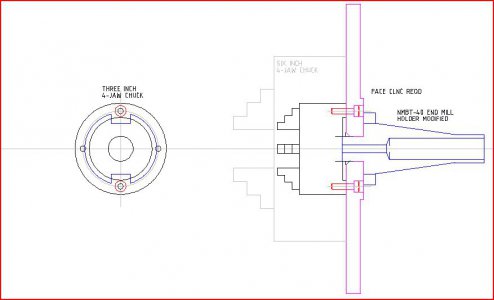- Joined
- Feb 5, 2015
- Messages
- 662
I agree with Jan, your taper will probably be less than optimum. You should follow his advice about checking fit, hand-filing and sanding as required until the fit is good. Relieving the center section of the taper is also an excellent idea. I also agree with Bob that you MUST have a means of securing the device to the spindle.
I don't know if the following will be useful since it wasn't designed for a lathe specifically. The intent is to provide a means of mounting lathe chucks to the spindle of a horizontal mill as well as a faceplate (to which the chucks are mounted). The mill can then be used as a lathe.
The reason is to increase swing capability - even a small horizontal mill can swing huge diameters compared to small lathes, when the over-arm is cranked back out of the way. Longer workpieces, if within the over-arm envelope, can be well-supported by using the over-arm as a tailstock and mounting a center in place of the end bearing.
Note that the tapered shank is threaded for a retaining bar. Also note that the faceplate can accommodate two different chucks, which you might also want to consider. The reason is that most larger chucks are rated at modest RPM while the smaller chucks can be spun up to much higher speeds.
One more point when considering mounting your chuck is to keep it as concentric as possible to the spindle axis. Out-of-balance situations can be dangerous as well as putting more load on the front spindle bearings than one might want.
That's equally applicable when securing odd-shaped work in a 4-jaw chuck or on a faceplate. Good practice suggests running the spindle much slower than normal if the work cannot be counter-balanced somehow.

I don't know if the following will be useful since it wasn't designed for a lathe specifically. The intent is to provide a means of mounting lathe chucks to the spindle of a horizontal mill as well as a faceplate (to which the chucks are mounted). The mill can then be used as a lathe.
The reason is to increase swing capability - even a small horizontal mill can swing huge diameters compared to small lathes, when the over-arm is cranked back out of the way. Longer workpieces, if within the over-arm envelope, can be well-supported by using the over-arm as a tailstock and mounting a center in place of the end bearing.
Note that the tapered shank is threaded for a retaining bar. Also note that the faceplate can accommodate two different chucks, which you might also want to consider. The reason is that most larger chucks are rated at modest RPM while the smaller chucks can be spun up to much higher speeds.
One more point when considering mounting your chuck is to keep it as concentric as possible to the spindle axis. Out-of-balance situations can be dangerous as well as putting more load on the front spindle bearings than one might want.
That's equally applicable when securing odd-shaped work in a 4-jaw chuck or on a faceplate. Good practice suggests running the spindle much slower than normal if the work cannot be counter-balanced somehow.

Last edited:

